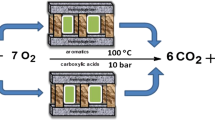Abstract
Microporous pillared clays (PILC) were prepared by the intercalation of montmorillonite with particles of titania (Ti-PILC), zirconia (Zr-PILC), alumina (Al-PILC), iron oxide (Fe-PILC) and mixed lanthania/alumina (LaAl-PILC). Nitrogen adsorption isotherms (77 K) and XRD data provided information on the porosity, surface area, micropore volume and interlayer distance of these samples. The surface area varied between 198 and 266 m2/g for Ti- and Fe-PILC, respectively. The titania pillared clay had also the highest micropore volume (0.142 cc/g) and interlayer spacing (16–20 Å), compared to the Zr-PILC, which had the smallest spacing between the layers (max, 4 Å). Despite this fact, Zr-PILC always showed a high adsorption capacity for gases such as N2, O2, Ar or CO2, due to its high adsorption field in the very small micropores.
From gas adsorption experiments on these various PILCs, it became clear that their adsorption properties depend on the pillars in three ways: (i) the pillar height, (ii) the distribution of the pillars between the clay layers and (iii) the nature of the pillaring species.
The incorporation of other elements in the pillars leads to specific adsorption sites in the pores. This was demonstrated by the preparation of mixed Fe/Cr and Fe/Zr pillared clays. Compared to the parent Fe-PILC, the incorporation of chromium and zirconium in the iron oxide pillars had a positive influence on the adsorption capacity. Also the modification of a PILC with cations increases both capacity and selectivity for gases. This was confirmed by the increased adsorption of N2, O2 and CO2 at 273 K on a Sr2+ exchanged Al-PILC.
Similar content being viewed by others
References
Adams, J.M., “Synthetic Organic Chemistry Using Pillared, Cation-Exchanged and Acid-Treated Montmorillonite Catalysts-A Review,”Applied Clay Science,2, 309–342 (1987).
Baksh, M.S.A. and R.T. Yang, “Unique Adsorption Properties and Potential Energy Profiles of Microporous Pillared Clays,”AIChE Journal,38, 1357–1367 (1992).
Burch, R. (Ed.),Pillared Clays, Catalysis Today,2, (1988).
Burch, R. and C.I. Warburton, “Zr-containing pillared interlayer clays. I. Preparation and Structural Characterisation,”J. of Catalysis,97, 503–510 (1986).
Butruille, J.-R. and T.J. Pinnavaia, “Alumina Pillared Clays: Methods of Preparation and Characterization,”Characterization of Catalytic Materials, I. Wachs (Ed.), pp. 149–163. Butterworth-Heinemann, Boston, 1992.
Dyer, A. and T. Gallardo, “Cation and Anion Exchange Properties of Pillared Clays,”Recent Developments in Ion Exchange, P.A. Williams and M.J. Hudson (Eds.), pp. 75–84, Elseviers Science Publishers, London, 1990.
Gregg, S.J. and K.S.W. Sing,Adsorption, Surface Area and Porosity, pp. 94–102, Academic Press, London, 1982.
Izumi, Y., K. Urabe, and M. Onaka,Zeolite, Clay and Heteropoly Acid in Organic Reactions, pp. 49–97, Kodansha Ltd., Tokyo, 1992.
Mitchell, I.V.,Pillared Layered Structure: Current Trends and Applications, Elsevier Applied Science, London, 1990.
Molinard, A., K.K. Peeters, N. Maes, and E.F. Vansant, “Restoring the Cation Exchange Capacity of Alumina Pillared Montmorillonite through Modification with Ammonium,”Separation Technology, E.F. Vansant (Ed.), pp. 445–454, Elseviers Science B.V., Amsterdam, 1994.
Molinard, A. and E.F. Vansant, “Gas Adsorption Properties of Cation Modified Alumina Pillared Montmorillonite,”Separation Technology, E.F. Vansant (Ed.), pp. 423–436, Elseviers Science B.V., Amsterdam, 1994.
Rightor, E.G., M.-S. Tzou, and T.J. Pinnavaia, “Iron Oxide Pillared Clay with Large Gallery Height: Synthesis and Properties as a Fischer-Tropsch Catalyst,”Journal of Catalysis,130, 29–40 (1991).
Schoonheydt, R.A., J. van den Eynde, H. Tubbax, H. Leeman, M. Stuyckens, I. Lenotte, and W.E.E. Stone, “The Al Pillaring of Clays. Part I. Pillaring with Dilute and Concentrated Al Solutions,”Clays and Clay Minerals,41, 598–607 (1993).
Sterte, J., “Preparation and Properties of Large-Pore La-Al-Pillared Montmorillonite,”Clays and Clay Minerals,39, 167–173 (1991).
Vaughan, D.E.W., J.S. Magee Jr., and R.J. Lussier, “Pillared Interlayered Clay Products,”US Patent 4,271,043, 1981.
Author information
Authors and Affiliations
Rights and permissions
About this article
Cite this article
Molinard, A., Vansant, E.F. Controlled gas adsorption properties of various pillared clays. Adsorption 1, 49–59 (1995). https://doi.org/10.1007/BF00704145
Received:
Revised:
Accepted:
Issue Date:
DOI: https://doi.org/10.1007/BF00704145




